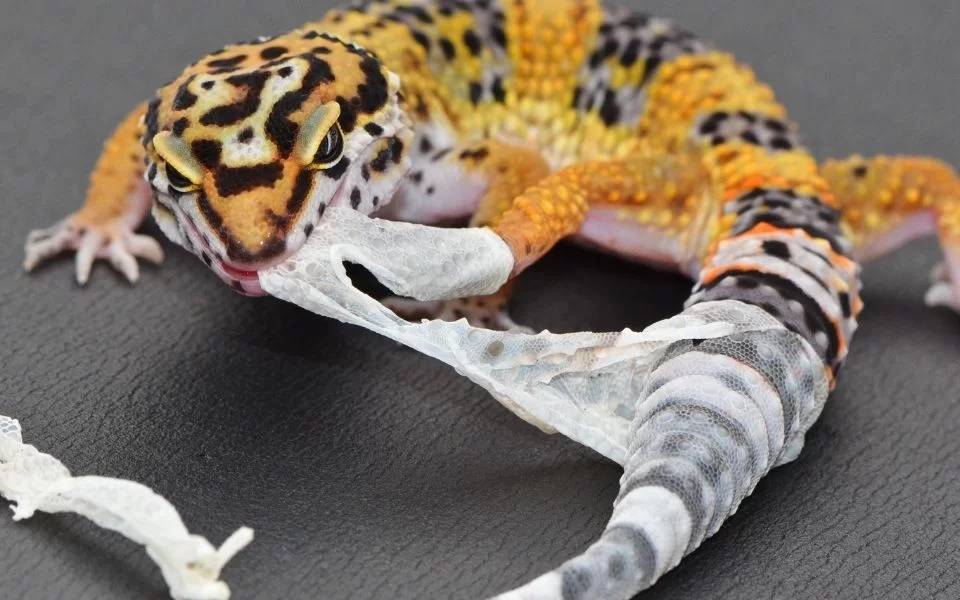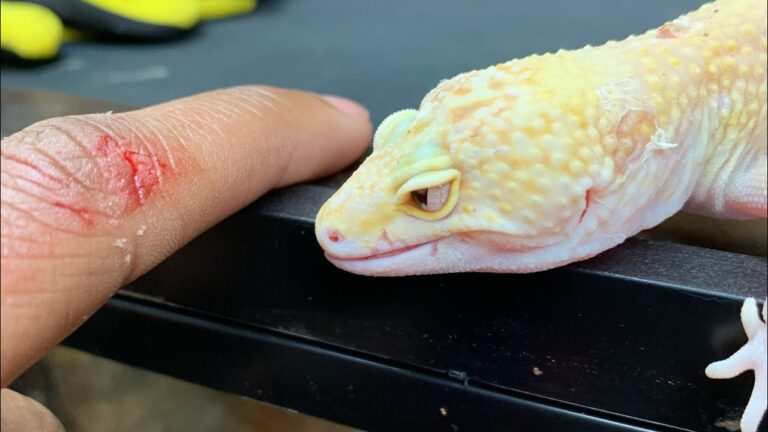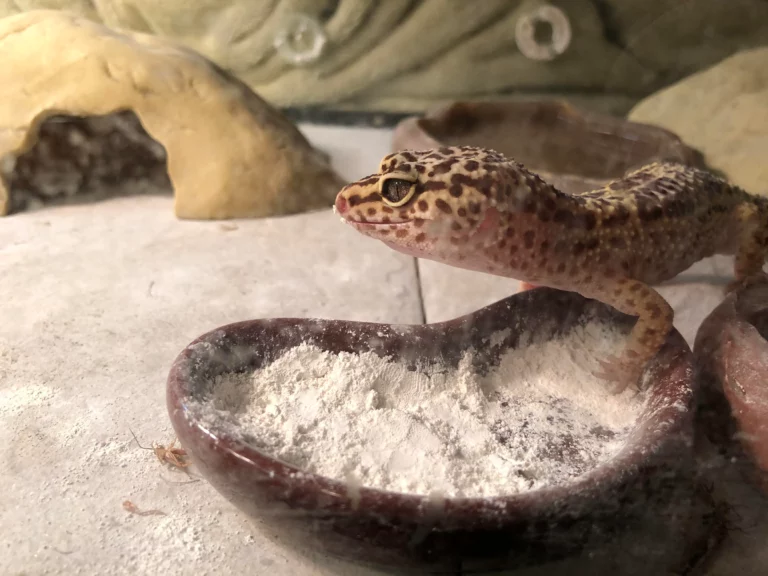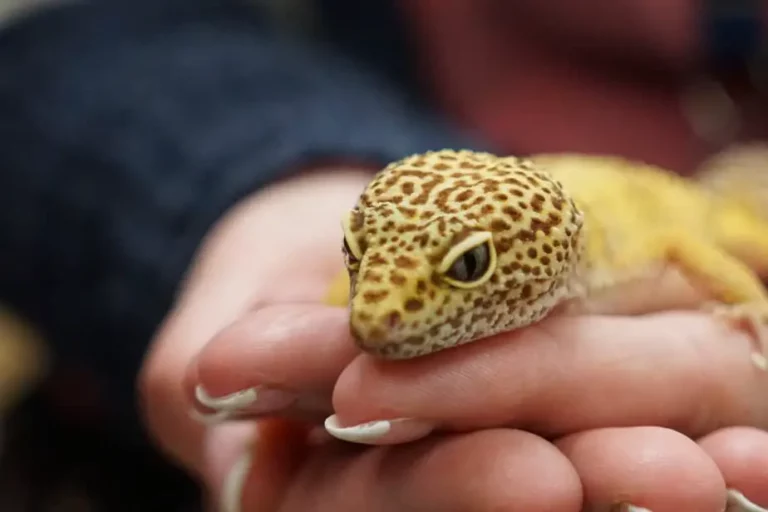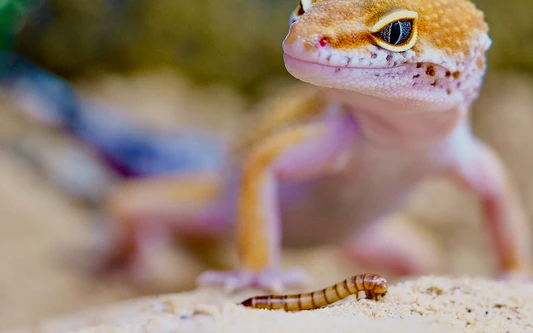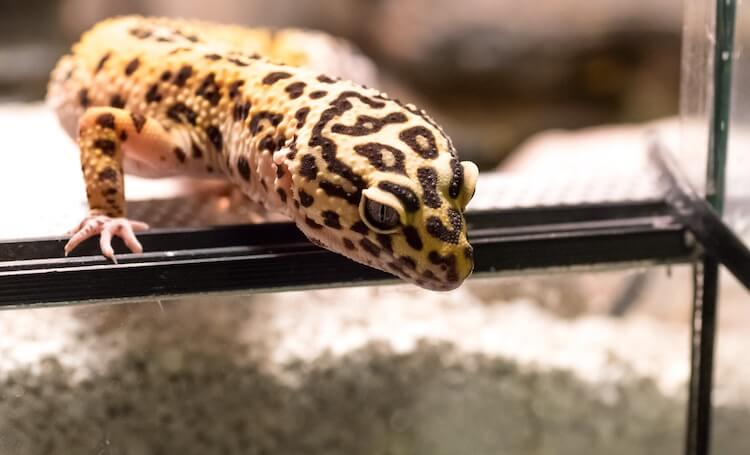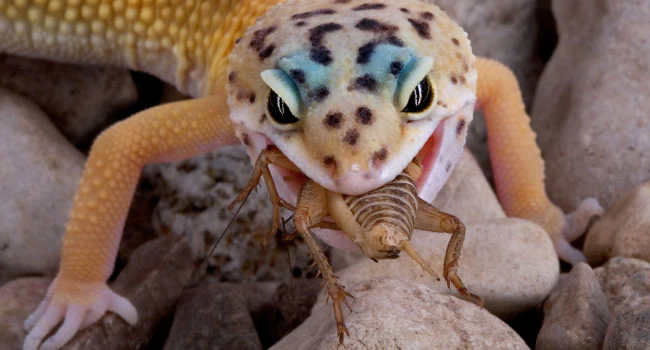Do Leopard Geckos Eat Their Shed: Unveiling the Fascinating Truth
Ever wondered if leopard geckos have a strange habit of munching on their own shed skin? Well, I sure did! Imagine this: I was in my reptile room, just hanging out with my leopard gecko buddy, Leo. He had just shed his skin, leaving a see-through, ghost-like shell behind.
Here’s the surprise: Leo started checking out his old skin! He stuck out his little tongue, sniffed around, and even took a nibble. It left me wondering, do leopard geckos actually eat their shed skin?
To solve this mystery, I decided to dig deeper and find out if this behavior is common and what it means for these fascinating reptiles. Geckos usually eat their shed skin each time they molt. They do this because shedding takes a toll on their nutrients and minerals. Eating the shed skin helps them regain some of these vital substances.
So, join me on this journey as we uncover the truth about leopard geckos and their shed skin-eating habits.
Why Do Leopard Geckos Shed Skin?
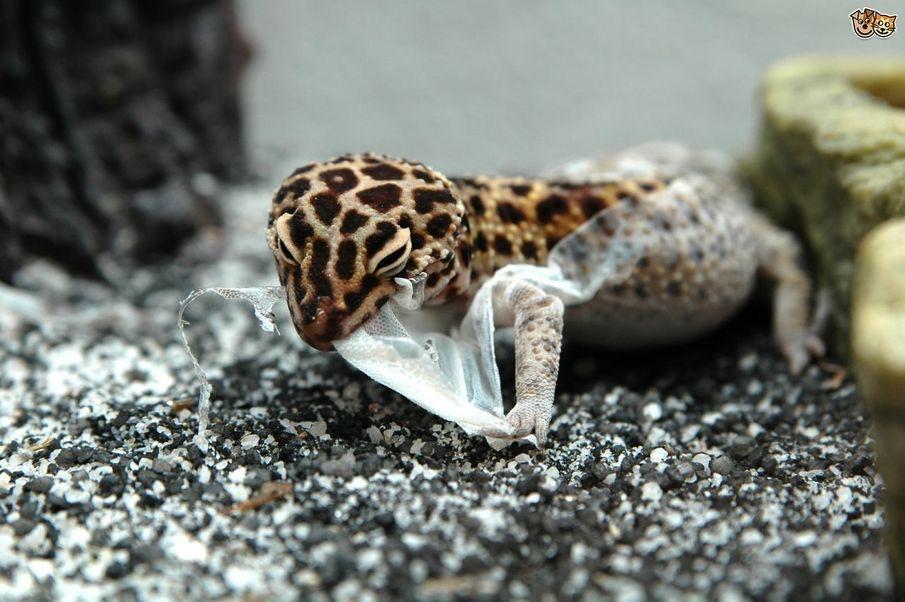
Leopard geckos, like many other reptiles, shed their skin as part of their natural growth and maintenance process. There are several reasons why leopard geckos shed their skin:
Growth: Leopard geckos continue to grow throughout their lives. As they grow, their old skin becomes too tight and does not provide enough flexibility. It allows them to replace the old, constricting skin with a new, more elastic one that accommodates their larger size.
Renewal: Also helps in renewing the outer layer of the skin. Over time, the outer skin can become worn, damaged, or contaminated with dirt and bacteria. Then, remove this old, potentially harmful layer, revealing a fresh and clean skin surface.
Healing: If a leopard gecko has suffered minor injuries or scratches to its skin, shedding can aid in the healing process. When they shed, any damaged or infected areas on the old skin may be removed, allowing the gecko to heal more effectively.
Parasite removal: Moreover, it can help remove external parasites like mites or ticks that may have attached themselves to the gecko’s skin. The process can dislodge these unwanted hitchhikers.
Hydration: geckos can absorb moisture through their skin, a process known as cutaneous respiration. Further, allows them to replace old, potentially dehydrated skin with a newer, more hydrated layer.
The shedding process in leopard geckos typically occurs in stages. It starts with the gecko’s skin becoming dull and opaque as a new layer forms underneath. Next, they will often become more reclusive and may not eat as much as usual. Eventually, they will shed their old skin in pieces or all at once, revealing their shiny, newly regenerated skin.
How do the eating habits of reptiles change during the shedding process?
Reduced Appetite: One of the most common changes is a decrease in appetite. As the old skin becomes tight and uncomfortable, they may not feel like eating as much or at all. This is a temporary behavior and is usually nothing to worry about as long as they are healthy and well-fed.
Increased Reclusiveness: They may become more reclusive during shedding. They may hide more often and avoid interaction with their owners or their enclosure. This behavior is a natural response to feeling vulnerable due to impaired vision and discomfort.
Decreased Activity: They may also become less active during this time .They may spend more time resting or staying in one place rather than exploring their enclosure or engaging in their usual activities.
Avoiding Handling: It’s generally best to avoid handling them, as their skin is delicate and prone to tearing. Handling can stress them further and potentially lead to skin injuries. It’s best to give them space and allow them to shed in peace.
Offer Water: While their appetite for food may decrease, it’s important to ensure that they stay hydrated that time. Provide a shallow dish of fresh water in their enclosure to drink from if they choose to. Proper hydration is essential for a smooth process.
Provide a Humid Hide: A small area of their habitat known as a humid hide keeps humidity levels higher. It can be easier for them to shed their old skin if they have access to a humid hide. Make sure it is easily accessed and kept up with paper towels or moist moss.
Post-Shedding Meal: After this, their appetite should return to normal. You can offer them a small, appropriate meal to help them regain their energy and replenish any lost nutrients.
Why do leopard geckos eat their shed skin?
Shedding skin can be quite exhausting for a leopard gecko, so consuming their own skin provides them with essential nutrients, eliminating the need to actively hunt for food.
It might come as a surprise, but your gecko is quite meticulous about maintaining its living space. Ingesting their skin serves as one method to keep their territory impeccably clean.
In their natural habitat, geckos face a diverse array of predators. Consuming their shed skin assists in concealing their presence and reducing the likelihood of detection by potential threats.
How to help a gecko with a stuck shed?
The most common problem areas during shedding, namely the toes and eyes, can be effectively addressed to ensure the shedding process completes smoothly. In some cases, simple adjustments enclosure can resolve these issues.
If insufficient moisture is the culprit, consider increasing the humidity level within the enclosure or hiding area, as this may resolve the problem. However, if the issue persists, there are additional steps you can take.
For Leopard Geckos with Shed Skin Stuck on Toes:
Create a shallow bath for your gecko, making sure the water is comfortably warm but not excessively hot. The water level should be sufficient to cover the gecko’s feet. Allow the gecko to soak in this shallow bath for approximately 15 minutes, but do not exceed half an hour.
Additionally, during this time, the skin should become softer, enabling you to gently remove the stuck shed with tweezers. If tweezers seem unsuitable, you can also try using cotton buds to assist in the removal process.
For Leopard Geckos with Shed Skin Stuck on Eyes:
Dealing with shed skin stuck on the eyes can be a more challenging situation. In such cases, you will need to create a sauna-like environment to facilitate the process. Find a plastic container of an appropriate size and add some air holes for ventilation.
In addition, line the container with a warm towel, place the gecko inside, and then cover it with a lid. Allow the gecko approximately 30 minutes in this environment, where the increased heat and humidity should soften the skin enough for removal with a cotton bud.
What are some common causes of stuck shed in Leopard Geckos?
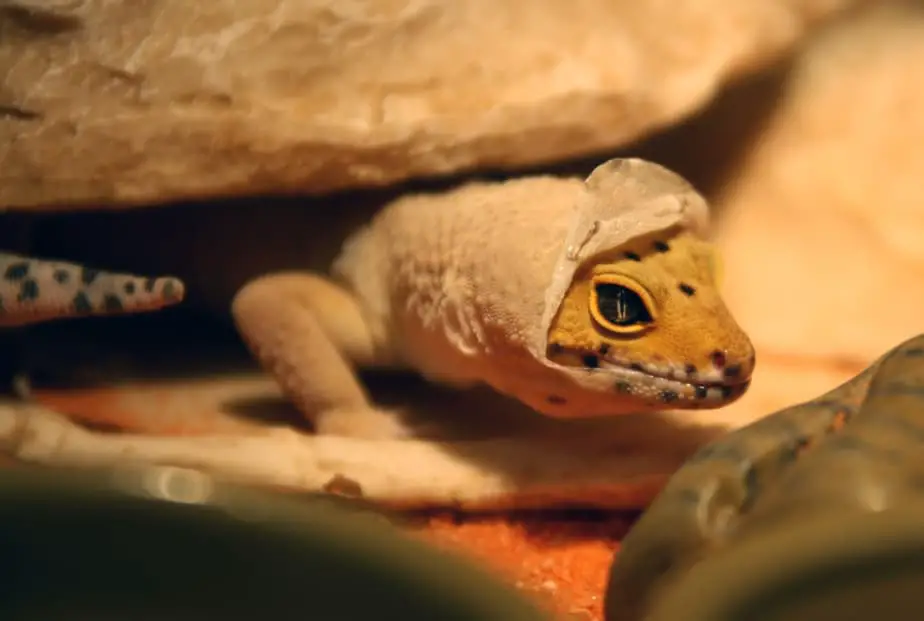
While the shedding process in a Leopard Gecko is typically straightforward, occasional challenges can arise, most notably in the form of stuck shed.
Stuck shed occurs when some of the skin the gecko is shedding remains attached. Several factors can contribute to this issue, including:
- Illness or stress
- Vitamin deficiencies
- Insufficient moisture in the enclosure or hiding area
- Inadequate temperature regulation within the enclosure
When skin becomes trapped during shedding, it can dry and harden, potentially leading to serious problems for the gecko.The feet are frequently the most susceptible part of the body to this problem since poor blood flow to the toes might result in toe loss or sickness.
Another concerning area where stuck shed often occurs is around the eyes. If the unshed skin dries around the eyes, it can prevent the gecko from opening its eyes, presenting a significant concern for the animal’s well-being.
Can I Help My Gecko During Shedding?
Yes, If you notice your Leopard Gecko moving around its enclosure with bits of skin still attached, you might be inclined to assist, but in most cases, they will manage the shedding process independently, typically within a span of 10 minutes to 2 hours, returning to their normal state. However, if you feel the need to aid them, there are several enclosure-related actions you can consider.
Creating an area of higher humidity within the enclosure can be particularly helpful. Alternatively, you can make their hide more humid than other parts of the enclosure. Introducing additional decorative elements that the gecko can use to rub against might also prove beneficial.
Apart from adjusting the enclosure, ensuring that their diet includes essential vitamin supplements can contribute to a smoother shedding process for your reptile companion.
It’s crucial to refrain from manually peeling any skin off the gecko. While it may appear helpful, this action can potentially damage the newer skin or even result in older skin becoming stuck. If shedding does become problematic and stuck, it may then be necessary to carefully assist in the removal of the skin.
FAQs
Why does my leopard gecko eat its shed?
Leopard geckos may eat their shed skin to gain nutrients, but it’s not their primary source of nutrition. It can also help keep their environment clean.
Do leopard geckos eat their skin after shedding?
Yes, leopard geckos may consume their shed skin, but it’s not always consistent behavior.
Do leopard geckos eat during the shed?
yes, Leopard geckos often reduce their appetite during shedding due to discomfort, but they should resume normal eating afterward.
Can I touch my leopard gecko after shedding?
Yes, you can handle your leopard gecko after shedding, but be gentle and avoid excessive handling to minimize stress.
Why do leopard geckos scream?
Leopard geckos do not vocalize in the same way mammals do. They might make clicking or chirping sounds when stressed or during mating.
Can leopard geckos hear you?
Yes, leopard geckos have a basic sense of hearing and can perceive sounds and vibrations, though their hearing is not highly developed.
Final words:
In conclusion, the question of whether leopard geckos eat their shed skin is one that has intrigued me as a reptile enthusiast. Through my observations, I’ve learned that while they may occasionally consume their shed skin, it is not a consistent behavior and should not be relied upon as their primary source of nutrition.
Furthermore, Shedding is a vital and natural process for these geckos, serving to facilitate their growth, renew their skin, and maintain their overall health.
Also, as a responsible caregiver of leopard geckos, it’s my duty to ensure they receive a well-balanced diet, maintain appropriate environmental conditions, and provide assistance when needed during the shedding process.
By offering the right care and attention to these remarkable reptiles, I can contribute to their overall well-being and ensure their longevity in captivity.

